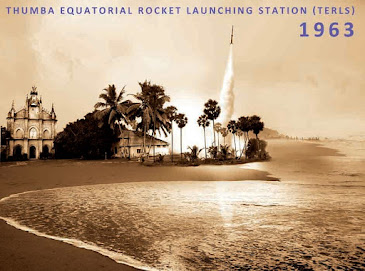Transported on a bicycle, launched from a church: The fascinating story of India's first rocket launch
From being transported on a bicycle to being launched from a church, here's how the India's first rocket reached the stars in 1963.
It was 53 years before, on November 21 1963, that a small rocket took off from Thumba on the edges of Thiruvananthapuram, reporting the introduction of the advanced space age in India. The tired palm-bordered town soon came to be known as Thumba Equatorial Rocket Dispatch Station (TERLS) and later became Vikram Sarabhai Space Center (VSSC).
Till 1963, the dark town of Thumba would not have justified another glance. A quintessential Kerala fishing villa with covered cabins, coconut forests and peaceful sea, it was a far-fetched setting for a rocket dispatch station. Nonetheless, it had something that got the interest of Dr Vikram Sarabhai, the father of India's space program. A small church devoted to St Mary Magdalene that was situated on the Earth's magnetic equator.
Sounding rockets, or the first rockets conveyed by any space program, test and study these electrons for research in the fields of physics, astronomy, and meteorology. These rockets are the baby steps taken before the establishment of a full-fledged space programme and Dr Sarabhai felt that Thumba was the best place to launch them. In fact, Thumba’s location at 8°32’34” N and 76°51’32” E is ideal for low-altitude, upper atmosphere and ionosphere studies.
So, one fine day, Dr Sarabhai and his fellow researchers (including Dr APJ Abdul Kalam) went to Thumba to talk with the then-bishop of Trivandrum who lived in the house adjacent to the church. They were keen on obtaining the church and the nearby land for their first rocket launch. Rather than offering them a definite response, Reverend Peter Bernard Pereira requested that they go to the Sunday mass that week, where he would put the inquiry to the parishioners.
At the mass, the minister clarified the logical mission and requested the consent from his assembly to surrender the church to the researchers. In his book Lighted Personalities: Releasing The Force Inside India, Dr. A.P.J. Abdul Kalam has depicted this specific incident beautifully.
On account of the Reverend's endeavors, permission was granted, the paper work was done and the residents migrated to another town with a shiny new church in 100 days flat. The bishop's house was immediately changed over into an office, the church turned into the office.Undeterred by the little funding and few facilities, a handful of enthusiastic young Indian scientists began assembling their first rocket.
In the underlying stages, Thumba had no canteen or facilities of any kind, so the researchers would cycle each day to the railway station at Trivandrum for their morning meal and dinner (they would get their lunch stuffed). Back then, the only jeep was consistently occupied, so the researchers needed to one or the otherswalk or utilize a cycle to move within the range..
In those days, even rocket parts and payloads were moved by bullock carts and bicycles to the launch pad. It was in these unassuming settings that India arranged its first launch—that of a Nike-Apache rocket provided by NASA. This is how it happened.
The Nike-Apache Rocket being brought to the Thumba launch Pad
After six months of labour, on 21 November 1963, India was prepared for its very first rocket launch. Numerous prominent names in science and innovation had accumulated for the event, including Dr Homi Bhabha (the dad of Indian nuclear program) and Dr P R Pirashoty (the father of Indian nuclear programme) and Dr P R Pirashoty (the founder-director of Indian Institute of Tropical Meteorology). The Governor of Kerala was also there along with the district collector and the bishop.
When the rocket was rolled out on to the launch pad, the sultry air was thick with tension. And almost immediately the things started going awry. As the rocket was being hoisted onto the launcher, the hydraulic crane developed a leak. Somehow, it was manually shifted into position. Next, remote system of the launcher malfunctioned. Once this was fixed, things finally seemed in order. As the alarm sounded to clear the area around the launch pad, the team of scientist held their breath..
At 6.25 pm, the world was looking as the rocket streaked away into the gethering dusk. Minutes after the fact, a sodium fume cloud had arisen in the out of this world above, colored orange by the setting sun. India had effectively put its first signature on space.
An elated Dr. Sarabhai sent a telegram home saying: “Gee whiz wonderful rocket show.” Dr Kalam later remembered how the very next day, Dr Sarabhai had congratulated the happy team and spoken to them about his dream of an Indian satellite launch vehicle. And over the years, Indian Space Research Organisation (ISRO) has not only fulfilled the visionary leader’s dream, but has also made India’s space programme the envy of the world with its ‘success on a shoestring’.
Fifty three years after the fact, Thumba is the center of all space programs helmed by the Indian Space Research Organisation (ISRO). The Vikram Sarabhai Space Center at Thumba has given India dispatch vehicles, geo-fixed satellites (utilized for media communications, TV transmission and climate anticipating) and the absolute best far off detecting satellites.
Concerning the little church that assisted India with trying to achieve the impossible, it presently houses a space museum center packed with an intriguing exhibit of rockets, satellites and other astronomical equipment.







Very nice!
ReplyDeleterelevent content
ReplyDeletenice work
ReplyDeleteexcellent work
ReplyDeleteDetermination always yields success
ReplyDeleteGreat work
ReplyDeleteVery impressive ☺️
ReplyDeletePretty informative 👍
ReplyDelete